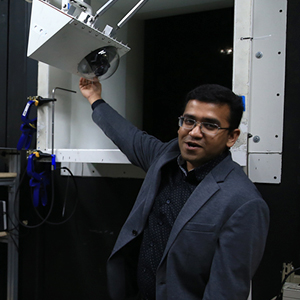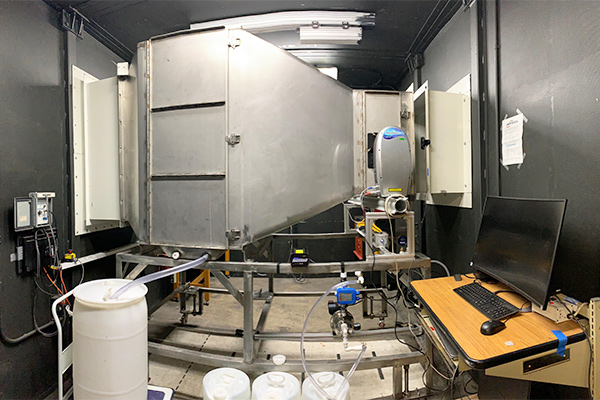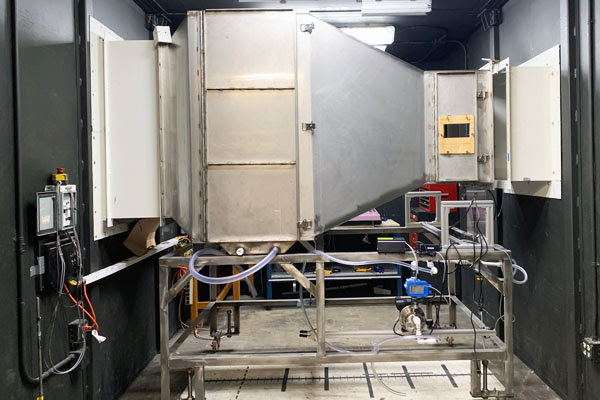Low-Speed Wind Tunnel
Optimizing Spray
The U.S. Environmental Protection Agency will accept and review results from spray drift experiments in the University of Dayton Low-Speed Wind Tunnel.
University of Dayton assistant professor of mechanical and aerospace engineering Sidaard Gunasekaran and his industry partner Kyle Butz, a technical adviser with Spray Analytics, believe the facility is just the second on a U.S. college campus to hold this designation. The other university facility is at the University of Nebraska.
Having the UD wind tunnel open for testing will help alleviate what can be a several-month backlog of agricultural and spray nozzle companies who must put their products through this testing to be approved for use in the field, according to Gunasekaran.
"With our facility, clients can test nozzle, pressure and tank mixture for applying treatments, and use the data to accurately predict the drift potential in the field," Gunasekaran said.
During testing, the wind tunnel is set to 15 miles per hour and the sprayer is set to the EPA-approved pressure for the mixture and nozzle being tested. Then, the duo sprays test samples from agricultural companies through a laser to measure the range of droplet sizes. The droplet size information is then used to understand the drift potential of each test combination.
"There are chemical, fluid and nozzle properties, plus spray pressure, that factor into spray efficiency," Butz said. "There have been lawsuits from drift claims. If I spray for a certain weed, and my neighbor's crop is not resistant to that, I can cause damage to them, and it becomes a civil issue."
"If we can optimize the way farmers spray, we should be able to keep the active spray on target. That way, the farmer is happy because he's maximizing coverage of their crop. And the neighbors are happy because they are not being impacted at all."
Adverse Effects of Lift-Induced Drag
Adverse effects of lift-induced drag on the aerodynamic efficiency of aircraft are well known. Lift-induced drag is generated as a byproduct of downwash from the wingtip vortices. We explored the flow physics associated with wingtip vortex core axial flow transformation from wake-like (velocity less-than the freestream) to jet-like (velocity greater-than the freestream) behavior in the vicinity of the maximum lift to drag ratio (L/D) lift condition.
Particle Image Velocimetry (PIV) experiments were performed at the University of Dayton Low-Speed Wind Tunnel in the near wake of an AR 6 wing with a Clark-Y airfoil to investigate the characteristics of the wingtip vortex at angles of attack ranging from 2° and 8°. Results showed changes in the velocity distributions in the vortex inner and outer cores. Vorticity and exergy distributions indicated the existence of the wake-like to jet-like transformation in the range of 4° to 6° angle of attack. This range corresponds with the maximum L/D angle of attack of the Clark-Y tested. A relationship between the vortex core axial velocity profile changeover and the angle of attack at maximum L/D was identified. Improved understanding of this relationship could be extended not only to improve aircraft performance through the reduction of lift induced drag, but also to air vehicle performance in off-design cruise conditions.

Significant, repeatable errors can result when loading off-the-shelf 6-component force transducers at relatively short distances off-axis. A number of permutations of off-axis loading were investigated to better elucidate the cause of the error. The magnitude of the measurement error provides substantial incentive to produce an independent sensor interaction matrix when test circumstances dictate similar off balance center loading.
Wind Tunnel Blockage Corrections
An investigation into wake and solid blockage effects of vertical axis wind turbines (VAWTs) in closed test-section wind tunnel testing is described. Static wall pressures have been used to derive velocity increments along wind tunnel test section which in turn are applied to provide evidence of wake interference characteristics of rotating bodies interacting within this spatially restricted domain. Vertical-axis wind turbines present a unique aerodynamic obstruction in wind tunnel testing, whose blockage effects have not yet extensively investigated. The flowfield surrounding these wind turbines is asymmetric, periodic, unsteady, separated and highly turbulent. Static pressure measurements are taken along a test-section sidewall to provide a pressure signature of the test models under varying rotor tip-speed ratios (freestream conditions and model RPMs). Wake characteristics and VAWT performance produced by the same vertical-axis wind turbine concept tested at different physical scales and in two different wind tunnels are investigated in an attempt to provide some guidance on the scaling of the combined effects on blockage. This investigation provides evidence of the effects of large wall interactions and wake propagation caused by these models at well below generally accepted standard blockage figures.

Inspired by birds’ covert feathers, previous research has shown that artificial self-deployable flaps placed on the suction surface of wings can act as a passive boundary layer flow control mechanism improving post-stall wing lift performance by as much as 15%. Parametric variations are performed in this study, to investigate the range of effectiveness of these artificial flaps.Subsequent experiments and complementary XFoil investigations revealed that each wing will respond differently to the placement of the artificial feathers depending on the wing’s stall characteristics, boundary layer thickness, and pressure distribution.




